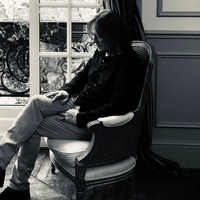On trusting your own sensibilities
Prelude
Cole Kush is an animator and music video director based in Victoria, British Columbia. He’s directed surreal videos for artists including Mac DeMarco, Jerry Paper, Nap Eyes, and TNGHT, and made a show for Adult Swim called Dayworld. He recently launched the artist-run streaming service Eternal Family.
Conversation
On trusting your own sensibilities
Animator and music video director Cole Kush on giving up a career in health care in order to become an animator, trusting your instincts (even when it’s scary to do so), and developing a creative platform in order to share the work of your creative community
As told to Max Mertens, 3180 words.
Tags: Animation, Art, Film, Beginnings, Inspiration, Multi-tasking, Mental health.
How did you first get into animating and making music videos?
It’s been roundabout. I’ve been interested in creative endeavors and making videos for as far as I can remember, back in high school, but I didn’t really go into a schooling path—my background is more in healthcare. I did this science degree and then this graduate program in clinical prosthetics, so for a while I worked across Canada treating patients who needed prosthetic limbs. I worked with amputees to fit their prosthetic limbs, get them up and running, and back into their lives. I learned animation through a research project I was doing about how to 3D-print prosthetic sockets, as opposed to traditional methods where you use plaster casting.
I grew up in northern Alberta, and lived in Edmonton for awhile, so I had a lot of friends who were in the music community. Some of them got a little bit bigger like Mac DeMarco. He had a circle around him of friends, like myself, who got a little more exposure. I was doing this 3D design and prosthetics, and I started bringing that into my music video work. Learning how to apply that 3D in a very sloppy way and animate some humans for this first music video, which was for a band called Walter TV, who I met through Mac. It was maybe nine or ten years ago.
Probably about six years ago is when I finally left healthcare, because I was getting enough stable work with videos and comedy and music videos and creative projects that I was like “I think I can do this.” So I basically left a stable healthcare career and just tried to do this full-time. It was extremely intense, and for a few years I was living on credit cards being like “Holy shit, what have I done? This is the stupidest thing ever.” But I just kind of stuck with it and kept going, and now six years later I’d say I’m probably at the point now where I’m making around what I was making in the healthcare, which is my only goal with this whole thing. I just wanted to do something I really, really wanted to do, which is this, and see if I could make it a stable income. I’d say I’m probably there, there’s still highs and lows, but the peaks are a little more stable.
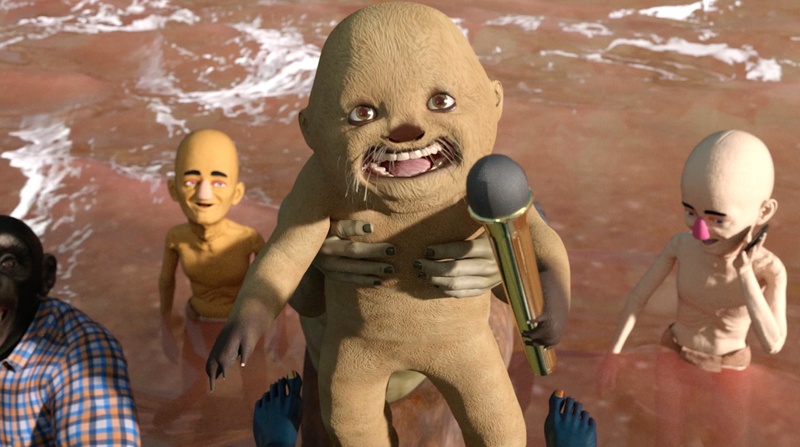
When did you move to Victoria and how has that impacted your work?
A couple years ago. I lived in Vancouver for awhile, Montreal, the East Coast as well. All across Canada, but we always loved Vancouver Island just because it’s a remote, beautiful piece of land, it feels a lot more calmer, rural lifestyle. We’ve been here for three years and absolutely love it.
Obviously it’s influenced the things that I’m making, but I think in general, it was a more functional decision out of the work that I do. I spend so much time staring at a screen in this sedentary state, anything that can bring me away from that is a positive thing. Living in much colder winter climates across Canada, when you enter those winter months you’re on the screen and then you’re not going outside either, so it can get really dark quickly just in terms of mental and physical health. Whereas here, there’s this beautiful outdoor landscape that pulls me outside. I’ll go for walks all the time, go hiking. It’s helped me to get to a place where I can create more consistently, because I’ve let go of that idea that you need to be in more darker states to be able to really create things. I think that’s incorrect. I think it’s a trap you can find yourself in. Ironically, I started to emulate the corporate structure, 9-to-5 kind of thing, just waking up and setting my to-dos and stopping at 5 PM. When I started doing that it just allows me to be more productive than I ever have.
How many projects do you generally have on the go at one time and how do you manage that workflow?
I probably spend less time on the technical animation side nowadays, more of just macro project managing. I still will animate with every project like a good chunk of the work, but I certainly have a good network of contractors and animators that’ll take on projects as needed. I would say right now I always have at least two or three projects that are active and some planned for the future. I’m usually putting all my energy into one at a time just for the sake of giving that project the energy it deserves. I find that when I start going hard into two or three projects at once, my attention gets spread a little too thin, and everything starts to suffer a bit.
I don’t even really put things in a calendar, the biggest tools that I use, one being the Boomerang feature on Gmail. If anything comes up like this interview or I’ve got certain deadlines or meetings, I’ll say remind me a few days before and send that away and it comes back. The biggest thing is I start every day by looking at the macro view of projects and all the to-dos. I’ve got lots of to-do notes, and then I pull out to three to five at the top, highest priority to-dos every morning, write them down on a little index card, and that’s kind of my goal for that day. I’ll try to get at least three of those done by the end of the day, and they also have to be very specific, palpable tasks. It can’t just be “finish music video,” it has to be like “render this scene or this hat on this character” or something like that. I’m sure this is very common knowledge to a lot of people but that’s what works for me for sure.
What do you look for in a collaborator?
I would say it started off more as friends sharing similar sensibilities, and then I’m pretty much guided by what is genuinely intriguing me as far as creators and what they’re making. If I’m connecting with the art, that’s the most important thing. In the past few years I’ve been more approached as opposed to seeking out, which has been nice, but it really comes down to if they send me a song and I’m into it. That’s pretty much the only factor.
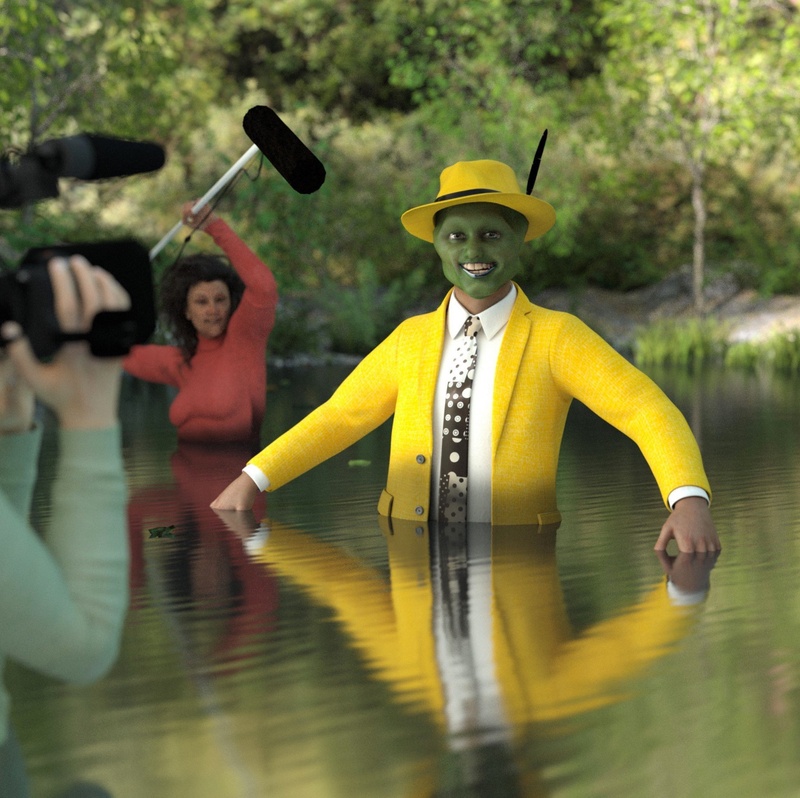
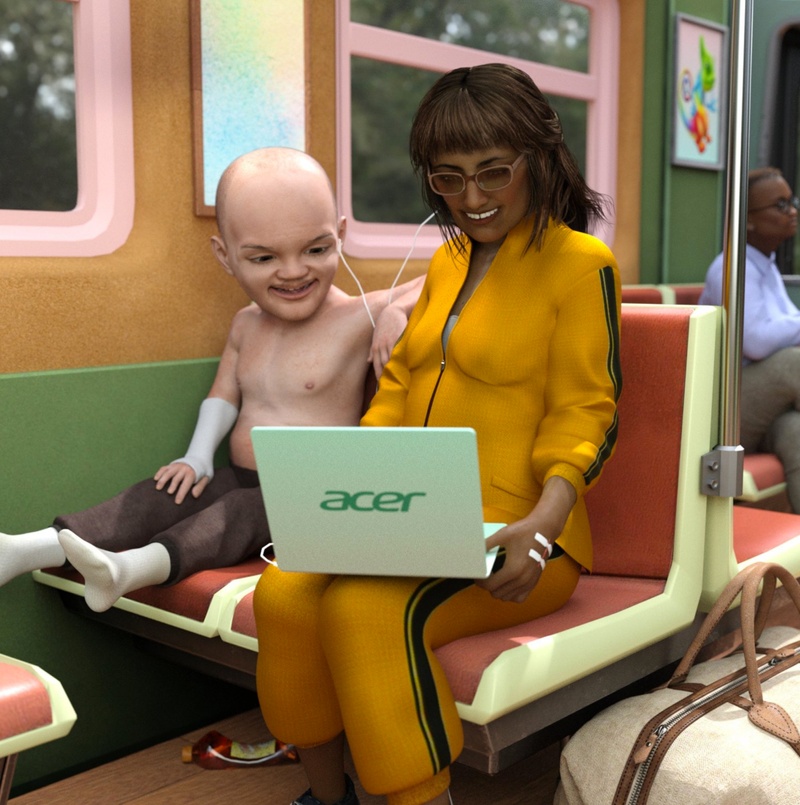
You said you didn’t have any formal training, but I was wondering along the way if there’s anybody who you really looked to as a teacher or mentor?
Certain people along the way for sure. For the Dayworld project, I ran a studio called Daytime Studio with this guy Derrick Guerin. He came from a fine arts background, so he brought a lot more theory and a lot more background detail on how to create more depth to scenes. Alan Resnick, he was the creative director on Dayworld, he gave me a lot of things to think about as far as color palettes and just general art direction and sensibility of creating something cohesive. Laura, my partner, she’s a sculptor and a huge help all the time with everything. Whenever I’m creating characters, she’s got a real eye for facial morphology in all three dimensions so she can really help me, especially if I’m trying to make a character from a photograph.
Is that vice versa? How do you help her with her work?
Oh yeah. Any digital aspect of her work in the past I help her with, because she’s very tactile with her hands, and I just live on a computer. It’s a good relationship in that way, we can help each other out.
Growing up, how did you consume music videos and were there any that you consider formative?
I grew up in Grande Prairie, which is this northern oil town in Alberta in this suburban neighborhood, and basically I was on the computer and the internet the entire time growing up. When I was really young, like ten, 11, 12, I remember I had a file-sharing site—before Napster and all that—and I had some movies on there, and somebody uploaded a few albums that opened up some doors. One of them I think a little later was Modest Mouse’s The Moon and Antarctica, I remember listening to that, and that just kind of opened up this big door of “Oh wow, there’s really no limitations to what music can sound like.” That led to exploring other bands. Before that, I was really into Tool.
I was going to ask.
I was a huge legit fan of those music videos too. Even when I was working with Conner [O’Malley] on that video [“Hudson Yards Video Game”], it was going to be a 30-second Tool snippet, and I was like “Can we do a full Tool video? I feel like that would be way funnier.” And he was definitely into it, but I also noted, “Just so you know, I legit love these music videos, I don’t want to goof on these music videos too hard.” I hope the spirit of that was captured.
Are there any videos or directors right now inspiring you?
There’s definitely things that pop up now and again. I’m not too in the loop with a lot of things, I keep a pretty simplistic life. Anything outside of work I’m not really trying to spend time with.
Do you find that helps you keep your creative vision clear that you’re not taking in too many other videos?
I think so. I think it certainly helps to explore more areas without influence, but at the end of the day, you can’t make anything without being influenced. You’re always pulling from something. I’ve been in the habit lately of trying not to shut ideas down too soon, whereas I used to be really hard on myself. I’d have an idea, start making it, and then be like “This reminds me too much of this.” Or even when people pitch ideas. I’m trying to stop that, because you’ve got to put more trust in your own sensibility and your own process, especially when you work through something over the course of a few months. Sure, it may start looking like something else, but you’ll find your own thing if you have a specific voice and something to explore. I think it’s important to follow things through even if you are feeling like it’s slightly derivative at the start, keep giving it energy and thought and refinement, and you’ll make something interesting.
Is there an example of when you had an idea and immediately were like “This won’t work,” and then years later or months later found yourself revisiting and turning it into something?
One thing that pops into my mind, you were talking about influences before with music videos, but with other things outside like comedy. The Kids in the Hall was huge for me growing up and that led to Mr. Show. I remember learning about Tim & Eric, this was back 12, 13 years ago, they’re huge for me. Anything that I’ve made in the past while for sure starts off like “Oh this feels like a Tim and Eric idea.” I feel like a lot of people have that issue as well in this particular alternative comedy genre. Years ago I was putting a lot of effort into trying to develop my own voice and tone in that style of comedy, but it’s kind of neat to come full circle and have Tim enjoy my work and approach me and say “Let’s make something together,” and that’s what lead to Dayworld. I’m hugely grateful for the opportunity because I’m a massive fan.
Tell me about the impetus for Eternal Family and why it was important for you to create this subscription-based platform to share content.
The particular idea started after Dayworld a few years ago, there was a bit of feedback from the network that they liked the Dole character, which is this character that I made years ago. So in my mind after I was like “Okay, I’ll take out that character, and it would be cool to make some new characters, and maybe make it more of a variety show with a little more energy and dynamic.” I developed this idea called Eternal Content, and it was basically this idea for a variety show that was set in the future, it was this mandatory entertainment channel for people who have uploaded their sentience into the cloud.
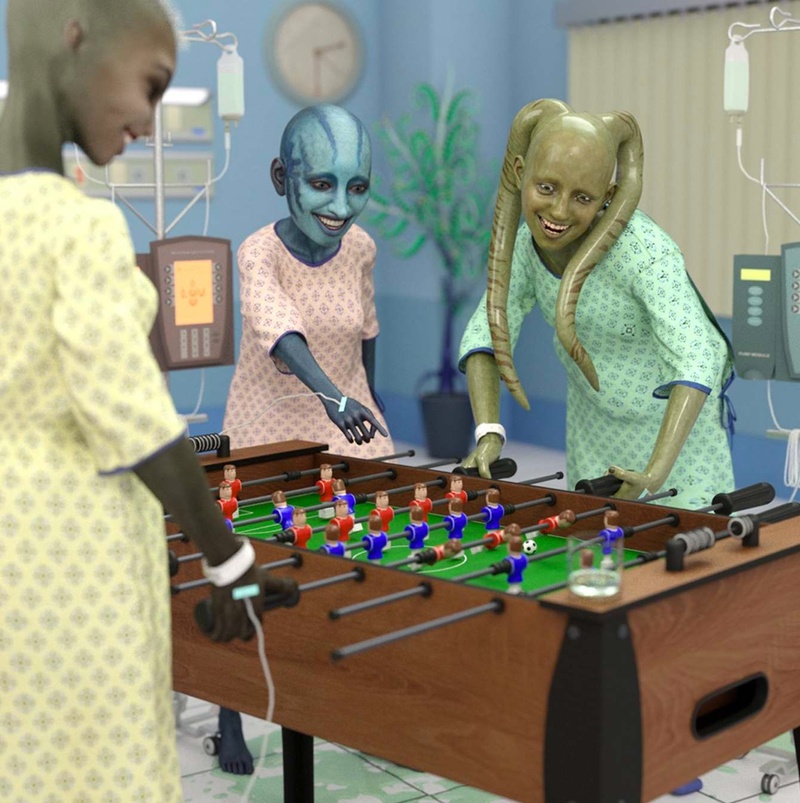
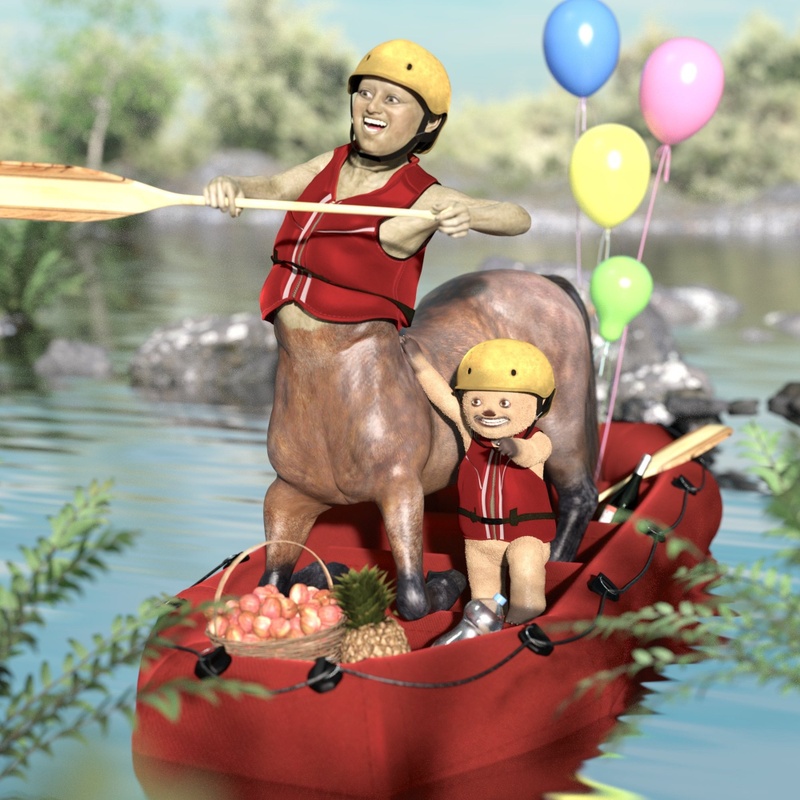
I pitched that around and the network was liking certain aspects of it, but maybe not the whole thing, and that whole pitching world tends to take a long time, months will go by before you get responses. I find that I have a lot of energy for these ideas, and I can make them myself, so why not do that? I started looking at other avenues. First it was Patreon, but with animation being so time-sensitive I didn’t know if I could really warrant a monthly thing, and crank out that much work. But then I also thought maybe there was a way to bring in some friends and collaborate with artists that I loved to make something more collaborative and have some type of revenue-sharing model.
I did the research and I found this one multi-creator revenue model, which is like 40% goes to operations and managing the whole thing, and 60% of the monthly revenue would be distributed to the creators based on view time. Then I found this monthly service called Uscreen, and you pay a monthly fee and they handle all the video hosting and the organization and the users, and you basically design the front end and customize it with your own brand. So I reached out to a handful of people that I collaborate with a lot and said, “Here’s this thing I want to make and basically it would just be a place to try out ideas that are not too labor-intensive, maybe things that you can’t pitch to an network that you can just produce yourself easily, and let’s try to build a little network of fun, interesting things.”
It was a pretty easy thing to pitch, actually. I think a lot of people who are more in the client network world appreciate having an outlet just to bang something out and have some fun. I’m pretty excited about the stuff that I’ve been getting so far, I’d say there’s about a couple of hours of video on the site so far, and I’ve got a bunch coming down the pipeline. I’ve just been waiting for the right time to announce it, I’ve been working on it for so many months, but right now whenever there’s something so big happening globally it’s kind of weird to demand attention to this experimental art service. That seems a little low priority right now. Having said that, on the flip side, people could use a distraction while they’re locked down at home so we’ll see what happens.
What else do you do to achieve a healthy work-life balance?
Like I said, the biggest thing that I try is to disconnect at a certain time, but a lot of times it doesn’t happen. I’ve been thinking about this a lot—my dad grew up on a small farm in northern Alberta and I was talking to him recently, and he was saying there was never any division of work and home, it was just all the same. Feeding the cows in the morning or going outside to the field at nighttime, there’s always work to be done all throughout the day. I find it’s a little tricky now in the sense that the work I’m doing is very unnatural, it’s just sitting in a sedentary state staring at a computer. So there is a mental and physical limit to being able to do that, whereas I think when you’re outside being a little bit more active and using your body, it’s kind of easier to work throughout the day.
I also have pretty chronic migraine headaches that if I don’t control with stress reduction and lifestyle and diet and all those kind of things, it gets pretty bad. I get a lot of these health checks and walls that I’ve hit too many times, to the point where I’m like “Oh you gotta stop, you gotta get up.” I’ve got timers set up where I’ll do pull-ups and push-ups, and go swimming and play pickleball. Haven’t been able to do that lately, but yeah I’ve got these things, my whole life is just automated with robots telling me to do with my body. It’s kind of pathetic, but it works.
You became a father in June. Can you tell me a little bit about some of the challenges you’ve faced adapting to creating art while looking after a kid?
I would say it’s been more positive, even on the creative side, just in that it really focuses your time. When I’m in that office now, I’ve got this clock that’s running down all the time, and it’s like “use this wisely.” It’s a lot less opening up a tab and watching YouTube and social media and all that, it really does force you to be a lot more efficient. That, and just the other simple fact that I’m providing income for the family, so I really need to focus on my mind.
When I do get the time outside of work to just be present and spend time with my son Charlie, it’s also just incredibly inspiring seeing a child experience everything for the first time. Like we’re outside, I’m holding him and this massive crow flies by, and he’s laughing hysterically at this huge crow on a branch. I’m just like “Wow that’s the first time he’s seen a crow, that’s pretty wild.” Just the classic thing of seeing things through a child’s eyes. Everything is beautiful, I’m lucky to be alive for this weird, bizarre time.

Cole Kush’s five favorite things to do with his son:
1. Call out his name and pretend that I don’t see him
2. Watch the garbage truck together through the window
3. Smile at him through the rear view mirror while driving
4. Pretend to eat the toy he is playing with
5. Hug him and tell him that I love him
- Name
- Cole Kush
- Vocation
- Animator, Director
Some Things
Pagination
